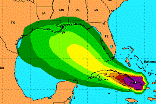
Here Comes Ike
Louisiana's Gov. Bobby Jindal issued a statewide emergency declaration on Sunday for Hurricane Ike, even as thousands of residents of his state were returning to their homes -- some of them damaged and many without electrical power -- after evacuating ahead of the earlier storm named Gustav. Jindal's declaration was based on the possibility Ike may make landfall on the Louisiana coast around Saturday, Sept. 13, 2008, as a Category 2 or stronger hurricane. Ike pounded Cuba on Monday, with 50-foot waves reportedly hitting part of the island.
Texas' governor, RIck Perry, also issued a disaster declaration on Monday for 88 of the state's 264 counties in advance of Ike's possible landfall on his state's coast. Texas has as many as 7,500 guardsmen and two search and rescue task forces ready to deploy, and its highway message signs are urging residents in coastal areas to make sure their vehicles have full fuel tanks.
Louisiana's coastal parishes are expected to issue their own emergency declarations. Louisiana's state Web homepage, www.louisiana.gov, is now titled emergency.louisiana.gov; state agencies and many other organizations are taking Ike very seriously. The state had an estimated 25,000 roofs damaged by Hurricane Gustav; FEMA and the Army Corps of Engineers are installing tarps free in 13 parishes for homeowners with less than 50 percent of structural damage. Jindal said yesterday that relief supplies have been slow to arrive, so the state was working with non-profits and private food suppliers to provide meals, water, ice, and other help to residents.
The National Hurricane Center shows a westward projected path once Ike leaves Cuba today. Hurricanes are unpredictable, and authorities caution that five-day forecasts are far from certain, but the storm's most likely path shows it headed toward Corpus Christi, Texas.